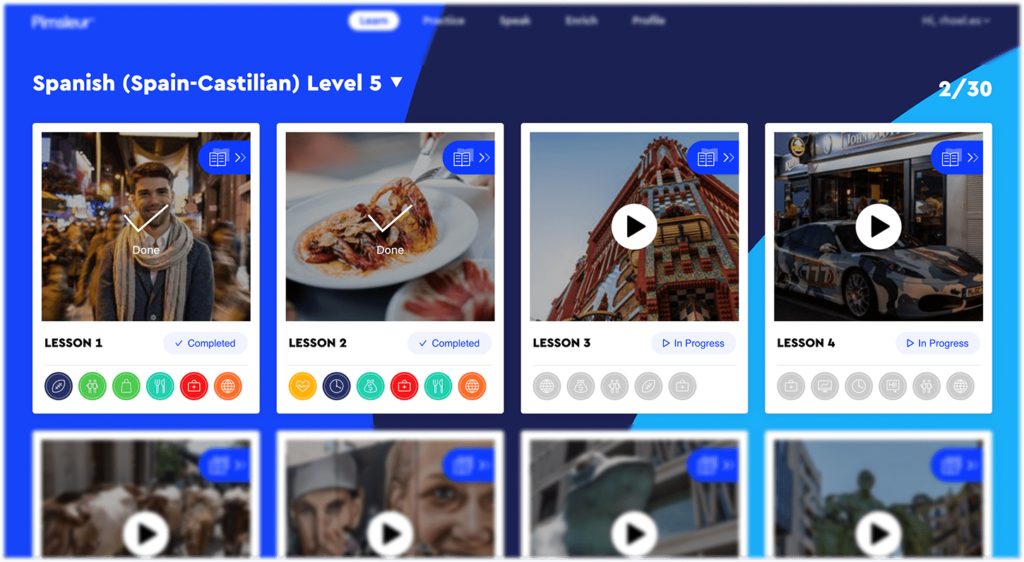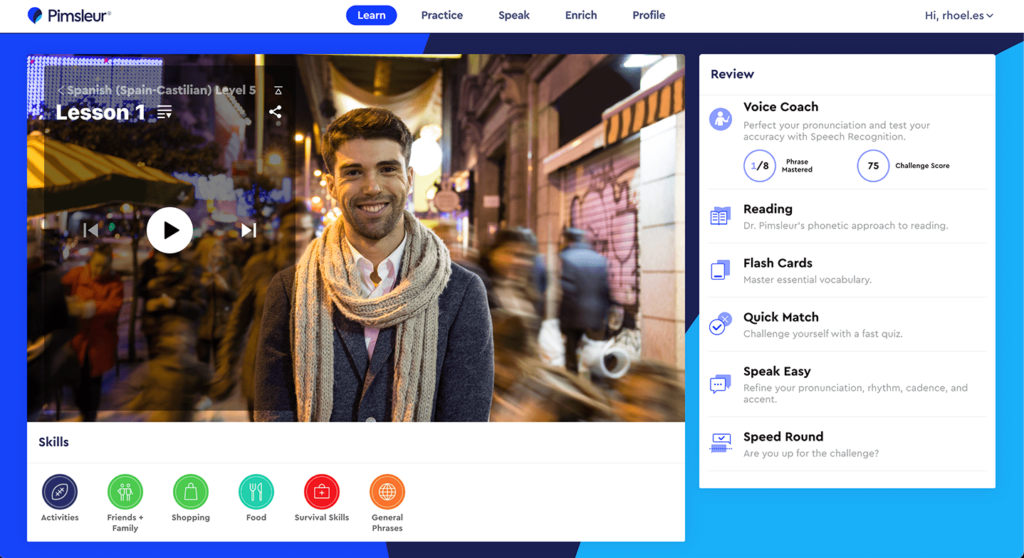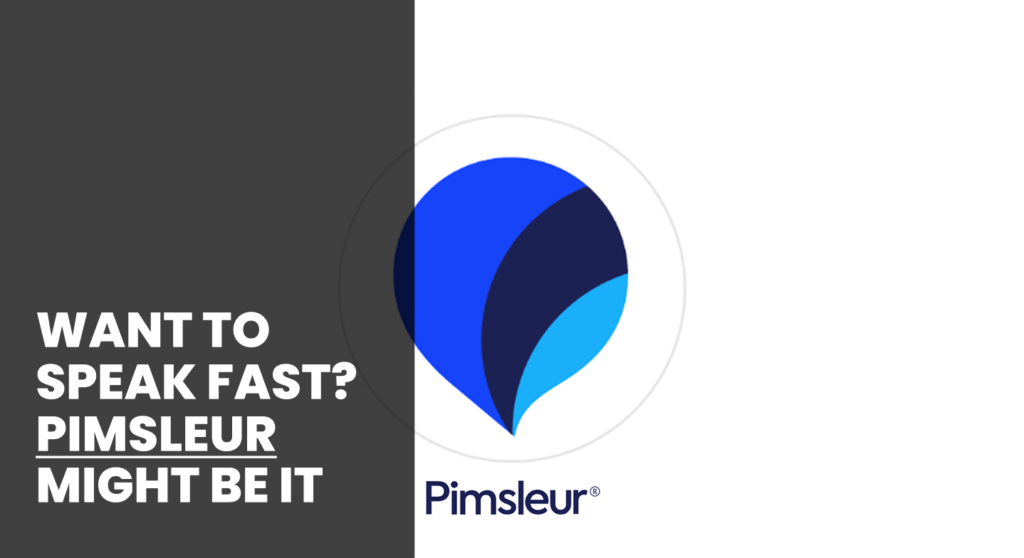Living in Madrid and not be able to fully express myself is tough. So, I’ve tried a lot of language apps to improve my Spanish, but Pimsleur is one of those that really caught my attention. In this Pimsleur review, I’m sharing what really worked—and what didn’t—so you can decide if it’s worth your time & money.
Spoiler: it’s not your typical app.
Quick Summary

1. What is Pimsleur?
Pimsleur is an audio-based app that helps you speak and understand a new language through real conversations. You listen, repeat, and then answer questions — learning the way you did as a kid: hear it, get it, and respond naturally.
Instead of boring school-style exercises like multiple choice or fill-in-the-blank that don’t help much in real life, Pimsleur focuses on actually using the language by speaking and listening.
2. How it works?
The method is pretty straightforward. Each day, you get to listen to a 30-minute audio lesson where a native speaker introduces new words and phrases. You don’t just passively listen — you repeat what you hear out loud and answer questions along the way. This back-and-forth helps you practice pronunciation and start building full sentences naturally.
In theory, you gradually build real speaking confidence and understanding. By focusing on speaking and listening, you start thinking in the language instead of translating in your head — which makes using it in everyday life much easier.
3. How lessons work?
- Each lesson introduces you to 5–10 new words or phrases
- You listen to native speakers and repeat out loud
- You’re prompted to respond in the target language
- Pronunciation is broken down to help you sound natural
- Afterward, you can review the lesson you´ve just finished with flashcards and quick quizzes
4. Special Features
- Voice recognition (for pronunciation practice)
- Offline mode
- Hands-free driving mode
- Cultural tips sprinkled into lessons
- Reading lessons (in higher levels)
- Flashcards and matching games for review
- Vocabulary saving feature lets you save words and phrases to review anytime
5. Pricing
No hidden paywalls — just one subscription to unlock everything:
- Free trial: 7 days (full access)
- Monthly subscription:
- $19.95/month (single language)
- $20.95/month (access to all languages)
🎧 7 Days. Zero Risk. Start your Pimsleur trial now.
What Makes Pimsleur Different from Other Apps

What sets Pimsleur apart is its focus on speaking and listening from day one. Unlike many apps that rely heavily on reading, writing, or flashcards, Pimsleur uses an audio-based method that trains your ear and your mouth at the same time. Each 30-minute lesson guides you through real conversations, teaching you how to respond naturally without memorizing long lists of vocabulary.
Another big difference is its gradual pacing. Pimsleur repeats key words and phrases in a way that helps you remember without feeling overwhelmed. You don’t need to spend hours a day — just a focused half-hour that fits easily into your routine. Plus, because it’s audio-focused, you can practice anywhere — walking, commuting, or doing chores — which makes consistent practice easier.
Quick Answer: Pimsleur is designed to build your speaking confidence quickly by getting you to actually talk, not just study passively. That’s why it works so well for people who want real, practical speaking skills. It’s kind of like building muscle memory—but for your mouth and brain. The more you practice recalling and using the words, the more natural it feels. So when you’re in a real conversation, the vocabulary actually comes out.
What I Like About Pimsleur
1. Speaking-Focused Approach
Let’s start with my favorite part about Pimsleur — it really focuses on speaking. From the very first lesson, you’re listening, repeating, and actually responding like you would in a real conversation. For me, that’s huge. Personally, speaking has always been the hardest part when learning a new language, and I like that I get to practice what I struggle with the most. I mean, isn’t that the whole point? We’re learning a language so we can speak it. And the only way to get better is to actually do it. Pimsleur gives you that space to practice — no fill-in-the-blanks or multiple choice stuff that never happens in real life. Just real speaking practice, every single day.
2. Hands-Free Practice
My second favorite part? You can use Pimsleur completely hands-free. I can do mindless tasks — chores, commuting, walking on the treadmill — while still practicing. It saves me so much time. I feel incredibly productive, like I’m hitting two birds with one stone. Instead of scrolling or zoning out, I get to squeeze in a full language lesson while getting other things done.
3. Minimalistic User Interface
Pimsleur UI is clean, easy to navigate, and intentionally minimal. There are no flashy animations, no clutter, and no gamified distractions trying to compete for your attention. It’s not trying to be a game — it’s just trying to teach you how to speak. That simplicity actually helps you stay focused. You open the app, press play, and you’re in the lesson. No extra steps, no wasted time. Just learning that feels clear and intentional.
4. Lesson Length
Lessons are short — at least for me. It’s just 30 minutes a day, which makes it a lot easier to build a habit and actually stick with it. It fits into a busy schedule without feeling like a huge commitment. And if you can’t finish all 30 minutes in one go, no problem. You can pause and pick it up whenever you’re ready. That flexibility makes it way more doable, even on hectic days.
5. Lesson Topics
The lessons focus on topics that cover from beginner (A1) up to intermediate (B1) levels. That means you get a solid foundation with practical, everyday language — things like introducing yourself, talking about your family, ordering food, or handling travel situations. It’s all stuff you actually need, not just random vocabulary.
6. Think Like a Native
Languages aren’t just about translating word-for-word — each one has its own way of expressing ideas. For example, in English, you might say, “I’m cold,” but in Spanish, you say, “Tengo frío” — which literally means “I have cold.” It’s not a direct translation, and if you tried to translate it word-for-word, it wouldn’t make sense.
Pimsleur helps you get this by teaching you the natural way phrases are said, not just the literal words. They break down sentences and guide you to think in the language, so you learn how native speakers actually speak — not just how to translate. That’s what makes your speaking sound more natural and less like a textbook.
7. Offers Offline Mode
Sometimes, I just don’t want to be bothered, so I turn off my mobile data or Wi-Fi to disconnect. That’s where Pimsleur’s offline mode really works for me. It lets me dive into my lessons without interruptions, so I can focus completely on practicing. Just me, the audio, and no distractions pulling me away. It makes those study sessions way more effective.
What I Don´t Like About Pimsleur
1. Pricy
Pimsleur isn’t free, and while the 7-day free trial is a nice touch, it’s barely enough to see if it really works for you. What stands out more is that it’s pretty expensive compared to other language apps out there. If you’re on a tight budget, this could be a big hurdle. So, it’s something to think about before diving in—it’s an investment, not just a casual try.
2. Split Speaking and Pronunciation Practice
Since Pimsleur focuses on speaking practice, I personally believe it should tell you if you’re saying things right during the lessons. For me, that’s a big deal. But the voice recognition only works in a separate pronunciation practice—not during the regular lessons. I’m not totally sure why they split it up like that. Maybe the idea is that during the regular lessons, you focus on thinking and responding in the language, while the pronunciation lessons let you zero in on just getting the sounds right. Still, I’d prefer if feedback was part of the whole experience, not just one section.
3. Not Aligned with CEFR
Pimsleur doesn’t clearly line up its lessons with the CEFR levels, and for me, that makes it harder to know exactly where I’m at or what I’m working towards. The CEFR is a handy way to see what skills you should have at each stage—from beginner to advanced—and without that, it feels like you’re guessing a bit. If you’re someone who likes clear goals or wants to take official exams, this can be frustrating. Pimsleur does help you build your skills step by step, but it’s not obvious how that matches with the CEFR, which can leave you wondering if you’re really on track.
If you’re just starting out with Spanish, I highly recommend familiarizing yourself with the CEFR (Common European Framework of Reference). It will guide you on what to focus on at each stage of your learning journey. Check out this article to get a clearer idea of what you should learn as a beginner and what’s expected of you along the way.
4. No Grammar Explanations
One thing I find lacking in Pimsleur is grammar explanation. I know some people say grammar isn’t necessary when learning a language — and maybe that’s true for kids who can just absorb a language naturally. But for adults like me, it helps to understand the why behind what we’re saying. From my own experience, grammar gives me a clearer picture of how the language works. Pimsleur shows you the right way to say something, but it doesn’t really explain why it’s correct. And without that, it’s harder to connect the dots — I end up second-guessing myself when I’m about to say something in Spanish. Sometimes, I even have to look things up elsewhere just to understand why a phrase was structured that way in the lesson.
Recommended Read: Unlike children, adults don’t absorb language just by exposure—we need active practice to make it stick. This blog explains—backed by science—why passive learning just isn’t enough for adults.
5. No Real Progress Tracking
Yeah, you can see what lessons you’ve finished, but it doesn’t actually tell you how much you’ve improved. There are no tests or assessments to show if you’re getting better at speaking, or understanding what you’ve learned. You kind of have to figure that out on your own. Personally, I would’ve appreciated some way to measure my growth. It’s hard to know if I´m truly making progress or just going through the motions.
6. No SRS, Only GIR
There’s no SRS (Spaced Repetition System) in Pimsleur — at least not the kind that actively tracks what you’re forgetting and brings it back just in time. What it uses instead is something called Graduated Interval Recall (GIR). This means certain words and phrases are repeated across lessons at spaced intervals. But honestly, I’m not sure it’s working for me. I kid you not, I take this app seriously — I pay full attention and even review what I’ve learned right after the lesson. Still, I find myself forgetting some of the phrases. Maybe it’s just how my brain works, but I feel like I need an actual SRS on the side to help things stick better.
7. Lessons are Limited
There are only 5 levels, and each one has 30 lessons. Sure, they cover a lot of useful, everyday phrases and vocabulary, but at the end of the day, you’re still confined to what’s inside the program. You’ll get a solid foundation, but you’re limited to those words and phrases. If you’re planning to go beyond the basics or reach higher fluency, you’ll need to supplement it with something else.
Can You Become Fluent Using Pimsleur?
Realistically speaking? No. And honestly, no single app is going to make you fluent. That’s just the truth. Pimsleur can help a lot, especially with speaking and listening, but if you’re aiming for fluency, you’ll need more than just one tool. Here’s why:
- Limited vocabulary and topics. The lessons cover everyday essentials, which is great at the start — but eventually, you’ll outgrow them. You’ll need to expand your vocabulary beyond what’s offered. There are hundreds of words in a language and Pimsleur can´t cover it all. And honestly, native speakers don’t really talk the way the app does. It’s slower, too clean, and way too scripted. It doesn’t fully prepare you for the speed and messiness of real conversations.
- You’re not pushed to express yourself freely. Pimsleur gives you ready-made phrases to repeat — which is helpful at first because you get a feel for how things are said. But the downside is, it doesn’t really train you to form your own thoughts in Spanish. You’re mostly repeating what’s fed to you. So while you might get good at saying specific things, when you’re in a real-life situation and need to say something that wasn’t covered in the lessons, you kind of freeze. You realize you were relying more on memory than actual language-building skills. For me, that’s a bit of a gap. Because eventually, you want to move from just mimicking to expressing your own ideas — and Pimsleur doesn’t quite get you there.
Who is Pimsleur Best For?
Not for Total Beginners
If you’re just starting to learn a language, I honestly wouldn’t recommend jumping straight into Pimsleur. At first, it might seem doable because the app asks you to repeat a phrase or a word — and that part is easy. But the problem is, it doesn’t explain why things are said that way. There’s no breakdown of grammar or sentence structure, so you end up memorizing phrases without understanding how they’re built. It’s like learning by copying templates, but not knowing how to create your own. And that’s super frustrating when you’re new to the language and still trying to wrap your head around the basics. You’re left repeating things without really knowing what each part means or how you could tweak it to say something else. So if you’re a total beginner, it can feel like you’re just parroting stuff without actually learning how to use the language.
Best for Intermediate Learners Who Still Struggle to Speak
Quick Answer: If you’re an intermediate learner who understands Spanish pretty well but finds it hard to speak, I’d definitely recommend Pimsleur. It focuses on the one skill most apps overlook: speaking. It trains your brain to pull the Spanish you’ve already learned and say it out loud without second-guessing yourself every five seconds.
One of the most frustrating things about learning a new language is definitely speaking it. On paper, I can construct sentences and express myself more easily and confidently. Not perfectly, but it’s way easier than speaking. Why? Because as an intermediate learner, I already understand the language better. I know how to conjugate verbs, use different tenses, and I’ve built up a good vocabulary from years of teaching myself Spanish — through listening to Spanish podcasts, reading Spanish transcripts, and talking to my Spanish-speaking coworkers.
But here’s the thing: I still struggle with actually speaking Spanish. That’s where Pimsleur really helped me. It didn’t teach me brand-new grammar rules — I already know most of that — but it gave me a space to use what I already know out loud. It helped me turn my passive knowledge into something active.Instead of just recognizing the language, I had to produce it.
Did My Spanish Improve Using Pimsleur?
I was already at an intermediate level when I started using Pimsleur. What intrigued me about it was that it’s nothing like the other apps I’ve tried. Most of them teach you how to translate, fill in blanks, choose from multiple options, or rearrange words. They help you understand the language, sure — but not actually speak it. Pimsleur, on the other hand, gets you speaking from the get-go.
At my level before started using Pimsleur, I can already understand Spanish pretty well. If a native Speaker talks to me, I get about 70–80% of what they’re saying. But the struggle has always been expressing myself. What Pimsleur helped me with is turning what I already know into spoken Spanish. So, did it help me improve? Yes — not in some dramatic overnight way, but gradually. I’ve noticed I pronounce words more clearly, I can recall vocab and phrases faster, and I don’t pause awkwardly as much as before. My Spanish is still far from fluent — I still mess up here and there — but this was definitely a good investment. I saw real improvement, and that matters.
Pros and Cons: Pimsleur Review Summary
👍 Pros
- Focuses on speaking and listening
- Hands-free and great for multitasking
- Simple, distraction-free interface
- Short, easy-to-fit-in lessons
- Practical, real-life topics
- Helps you think in the language
- Works offline
- Clean audio quality with native speakers
👎 Cons
- On the pricier side
- No pronunciation feedback during lessons
- Doesn’t follow CEFR levels clearly
- Lacks grammar explanations
- No progress tracking or assessments
- No true spaced repetition system
- Limited lesson scope
- Doesn’t support open-ended speaking or fluency development



